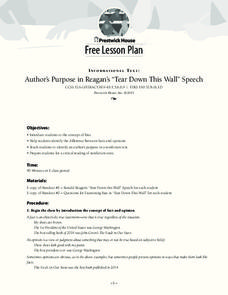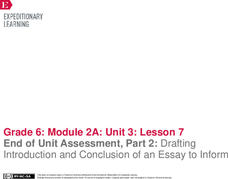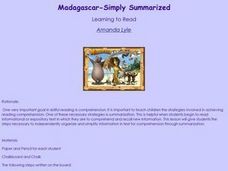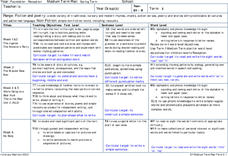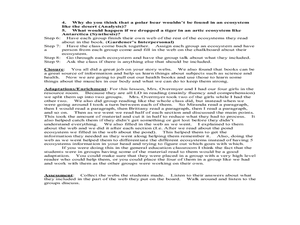Curated OER
Compare and Contrast Information from Multiple Sources - Wolong's Pandas
Students compare and contrast information on the declining population of pandas by looking at 3 different sources: one handout and two videos. Students generate ideas for why pandas are declining and fill out a compare/contrast chart of...
Prestwick House
Author’s Purpose in Reagan’s “Tear Down This Wall” Speech
President Ronald Reagan's "Tear Down This Wall" speech, delivered on June 12, 1987 before the Berlin Wall, provides class members with an opportunity to examine three key aspects of informational text: author bias, the use of facts and...
Curated OER
Foreshadowing and Prediction: W.W. Jacob's, "The Monkey's Paw"
W.W. Jacobs' story "The Monkey's Paw" provides plenty of foreshadowing which readers use to make predictions in this tightly composed, sound instructional plan. Your class reads the story, recording predictions and checking for veracity...
Curated OER
Comparing and Contrasting Fiction and Nonfiction Using Graphic Organizers
Learners compare and contrast fiction and non-fiction selections. In this writing skills lesson, students use different forms of graphic organizers to compare "The Three Little Pigs," to Wiesel's Night.
Curated OER
Connection Stems
Pupils connect their lives to a story or nonfiction text. In this reading connections lesson, students make text-to-self, text-to-text, and text-to-world connections as they complete connections stems based on a story.
EngageNY
End of Unit Assessment, Part 2: Drafting Introduction and Conclusion of an Essay to Inform
A powerful introduction and conclusion can really pack a punch. Using the resource, scholars first read and discuss a model essay. Then, as part of the end of unit assessment, they draft the introductory and concluding paragraphs of...
Curated OER
Reading Through Rainforests
Students investigate the concept of the rainforest through the use of nonfiction texts. The teacher reads to the class to give some information. Then they read their own books to find further information and perform the follow activities...
Curated OER
Abigail at Seventeen
Young historians analyze a letter 17-year-old Abigail Adams wrote to her cousin and identify the aphorism Adams used. Participants select a line from the letter and create an illustration of the aphorism.
Curated OER
Distinguishing Fiction and Non Fiction
Have your class go on picture walks of different books, and identify them as either fiction or non fiction and why. Working in groups, kindergartners state whether the book tells information or comes from the author's imagination. Use...
Curated OER
Compare and Contrast Passages
Combine two skills with the activities included here. Pupils not only practice determining the main idea of short passages, they also use a Venn diagram to compare and contrast the main ideas of the different passages. Start out...
Curated OER
Get to the Point!
Students summarize a selected piece of text nonfiction text. After reviewing the correct way to highlight important information, students read a nonfiction article. They write a summary paragraph using the five step process outlined by...
Curated OER
Madagascar-Simply Summarized
Students summarize a selected piece of text nonfiction text. After reviewing the correct way to read silently, students read a nonfiction article. They write a summary paragraph using the four step process outlined by the instructor. ...
Curated OER
I'm Thankful I Can Summarize
Students summarize a selected piece od nonfiction text. After reviewing the correct way to read silently, students read a nonfiction article concerning Thanksgiving. They write a summary paragraph using the five step process outlined by...
Curated OER
Ready, Set, Summarize
Pupils summarize nonfiction text. After reviewing the correct way to read in order to summarize, students independently read a nonfiction article. They write a summary paragraph using the three step-process outlined by the instructor...
Curated OER
Just Get to the Good Part
Learners summarize nonfiction text. After reviewing the steps for summarization, students independently read a nonfiction article. They write a summary paragraph using the six-step process outlined by the instructor during guided practice.
Curated OER
Short and Sweet
Students summarize nonfiction text. After reviewing the process for reading in order to summarize, students independently read a nonfiction article. They write a summary paragraph using the checklist outlined by the instructor during...
Curated OER
Identifying Main Idea
Pupils locate the main idea in a nonfiction text. In this language arts lesson, students participate in a think aloud to locate the main idea of the story. Additionally, pupils respond to a text and locate the main idea and complete a...
Curated OER
Pre-writing activities for improving students' connections to literature
Students, while reading a novel together in class, jot in their journals any connections to their own lives they can make between the text and self, text to text or text to the world. Various themes are connected to open more doors to...
Curated OER
Fiction and Poetry
Students explore fictional text and poetry. They explore the story structures used in the types of texts and examine the language patterns used. Students practice tracking text in the correct manner.
Curated OER
Mapping Out Summarization
Young scholars summarize a selected piece of text using a a six step process. After reviewing the correct way to read silently, students read a selected piece of nonfiction text. They write a summary paragraph using the six step...
Curated OER
Summarization
Pupils summarize a selected piece of text using the five Ws. After reviewing the correct way to read silently, students read a selected piece of nonfiction text. They write a summary paragraph using a process outlined by the instructor.
Curated OER
Graphic Organizers Aid Comprehension
Students create story webs to aid comprehension of ecosystems. In this reading strategies lesson plan, students discover the importance of organizing information while reading a nonfiction text. Students produce story webs to communicate...
Pennsylvania Department of Education
Stories? Information? What's the Difference?
Students listen to a power point presentation to distinguish between fiction and nonfiction text. In this what's the difference lesson, students identify fact from opinion within a text. Students listen critically and respond to text.
Curated OER
Observing the Pumpkin Cycle
Students observe and listen to nonfiction books about the life cycle of pumpkins. They practice early reading skills in a shared reading related to pumpkins. They observe the life cycle of a pumpkin including growth and decay.
Other popular searches
- Nonfiction Text Features
- Nonfiction Text Structures
- Types of Nonfiction Text
- Features of Nonfiction Text
- Fiction and Nonfiction Text
- Nonfiction Text Elements
- Infer Nonfiction Text
- Parts of Nonfiction Text
- Summarizing Nonfiction Texts
- 6 Nonfiction Text Structure
- Inquiry and Nonfiction Text
- Reading Nonfiction Text

